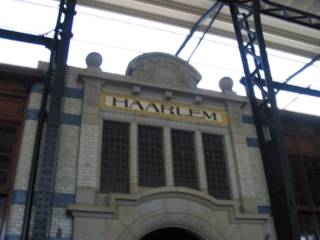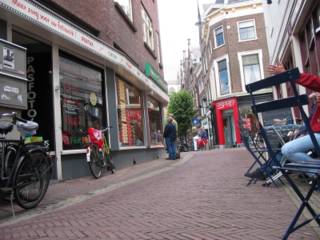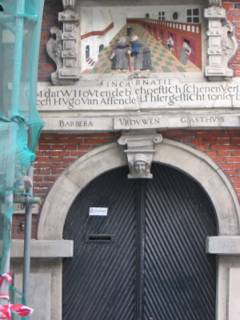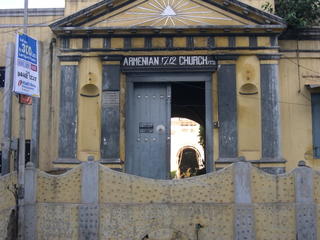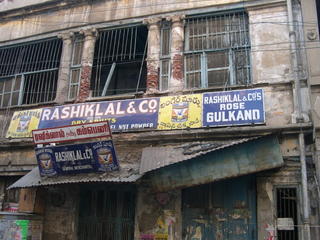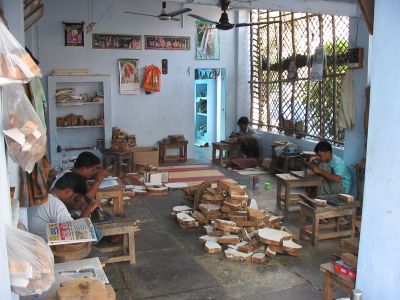In one of my earlier rambles, long time ago, I made some empty promises to review this book. Nonetheless, like a true person of modern times, I broke the promise and went on to start writing another series of blog. Which, incidentally, is yet to reach its final stop. Anyway, in a attempt to straighten up the matters, here is my first try to start the review process. I say review process since, before I start, I would like to take you'll on a slight detour as to how I got hold of this book. It is quite likely that this detour itself would fill up a blog by itself.
*(coming back from future, i can say: it did)*
This book was recommended to me by Robert, when I told him what kind of travel books I was looking for. R had a book stall at the weekly second hand book market at Spui (said Spow) in Amsterdam. Spui is a tiny square just off the main shopping street (Kalvestraat) of Amsterdam. Incidentally, this street few centuries ago was one of the first commodity market of the world, in addition to doubling up as the red light area once darkness fell. Years later, the authorities moved it around 'nieumarkt' area, where it still located. The red light area I mean. I have no idea where the current stock market is but then who wants to know that piece of information.
I was told by everyone, before I visited Spuii, that the second hand market has only Dutch books and old maps. To justify my trip to spui on a friday afternoon, I told everyone in the dept that I wanted to get myself an old Dutch map of S.India. Well, that was infact true since I wanted to get hold of an old map where Bhimipatnam and Mausilipatnam are in larger and in bolder letters than their neighbouring cities Visakhapatnam and Vijayawada.
However a tiny hitch was that I did not know the exact way to Spui, though I did know it is somewhere close to the famous Indonesian restaurant "Kantijl and de Tijger" and Amsterdam Historical museum. I was also sure I will reach there by few trials and errors. One doesnt get lost in Amsterdam, if you know roughly which direction your destination is from your starting point. I would have loved to talk of the cycle route from my room to spui, on which I traversed many a time after this trip, but I will leave that for another blog. So getting back, I did make it to Spuii and to the book market.
I started with the first stall on my left and then zig-zagged my way through the market. To say that all books in the market are dutch is not true. Each stall had a small row of books in various foreign languages, mostly European. Some put them in the front, others put them at the back and some other put them on one side. So, after few stalls, I started looking for a row of books that were away from the rest and nothing else. By this time, I also stopped looking for maps as the first few shops mostly had European cities and towns; the ones of S.Asia were British and by then 'Vizagapatnam' and 'Bezawada' were already prominant. Also, it was too painfull to flip through the large pile of maps, packed inside plastic covers.
In the second last stall on the right hand side, I noticed all books were in English. This made me look out for the owner: he was sitting on a long stool in front of the shop with a book in his hand as people were milling around him, looking up once in a while to take stock of the people in his shop, with a hand-rolled cigarette in his mouth.
To say that I spent a long time in his shop would be misleading. I spent so much time looking at the books that when I went to pay for some books I picked up,
he said "so, you have seen them all?".
"Yes, I replied but I could not get my hands onto any travel books", I said.
"oh, what kind of travel books? guides?"
"no, i am interesting in travelogues but I couldnt find any here", i replied
"travelogues?, i have many at my regular shop" and went on to dig a business card from his pocket.
that was when he said "I am Robert and this is my shop", while giving me his card.
I looked into it, it said "Timbuctoo Antiquarian Books: Travel, History, Literature"
and as I was reading it he said, "now that you have told me, I will bring some next week"
"that would be nice", i replied.
I could not go to Spui for about 15 days. Next time when I went, I went straight to R's stall. He had some travel books. though not as many as he brought the previous weeks he told me. As I was looking the collection, he comes over and started asking me about the travel books I read and authors I know. Then he started picking up some books and said, "I would recommend these". As I started to look at the books, he explained about each of them. I kept some and put some back. Among the ones I kept is this book: 'Voices of the Old Sea'.
The author, Norman Lewis lived for some time in a Spanish village on the coast right after the war. He indulges in the same activities as the men in that area did- all related to fishing- in ways that have not changed for centuries. He then goes back for two successive summers to participate in the 'sardine catches'.
Next time he visits it, 25 years later, he experience a drastically changed topography. There is only tourism industry and the place was certainly not the Spain he knew. The moneyed from northern Europe seem to have completely destroyed the old life style and now, things are all "tourist centered".
He then sits down to write a chronicle of the three summers he spent in that village. The name of the book comes from a coversation he had with an old fisherman. He asked the fisherman on how the 'recent' changes were likely to affect his future. for which the fisherman replied: "how can anyone say? One thing is certain. here we have always been, and here, whatever happens, we shall remain, listening to the voices of the old sea"
In what seemingly seems to be my behaviour on DSS - write blog in parts that are spaced out from one an another - I will put up the actual review in the next part.
Meanwhile, here are two pictures of Spui

spui

spui

